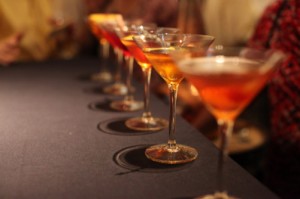
Stephen Dennison is a Chef/Mixologist, Beverage Consultant and a regular contributor to BourbonBlog.com
Like writing a short story, a cocktail tells a tale just 30 seconds long and takes the reader on a mental journey. Whereas a good book communicates the information through the sense of sight, the libation does so through the sense of taste. When designing a new cocktail, one should heed some of the same rules that apply to the literary realm, most notably the purpose of the work. We have fallen into the assumption that all cocktails are to be placed onto a drink list, given a catchy name and served over a bar with hopes that some bartender on the other side of the world will have heard of our work and be able to replicate it when approached. This shouldn’t be the case, as I hope to show there are many situations that can call for a wide variety of expressions from a creative point-of-view.
To begin, the target audience must be considered. Are you speaking to the Cosmopolitan/ Lemon-drop, or the Sazerac drinker? Adventurous or conservative? Young or old? What are their perceived expectations with regards to time of preparation? Would they enjoy the show inevitably associated with some crafted cocktails, or do they shun such flashy presentations? Considering these topics will allow you to give the individual exactly what they are looking for in the experience and will replace these minor criticisms with praise, because you will have given exactly the experience they desire.
Next, the question of perspective: The author must speak with 1st, 2nd or 3rd, yet the bartender must choose a voice that is classic, modern or a hybrid of both. This is a very subjective expression that is amorphous and truly is a place where the individual’s own aesthetic should shine through. For me to list examples would only press upon you, the reader my own personal opinion and I feel this would defeat the very purpose of my words here, so leaving this open-ended seems to be apropos.
An important and commonly overlooked aspect is format. The writer must consider whether they are writing a short-story or novel. The bartender must consider their own time of preparation, with the distinction that they must do this at various levels of repetition. Is this work to be placed on a cocktail list, to be reproduced by other bartenders? Is it an event-specific offering to be served at a wedding or festival? A contest drink to be produced 5 times? Easy to be reproduced by the nonprofessional- at home, as in a cocktail-class setting? A thing of humor and perhaps an example of a new technique found? I cannot stress enough the importance of this consideration, as I see the cocktail culture deepening and widening for quite sometime and feel that these various formats will continue to present themselves in unexpected and ever-changing ways…
Finally, the actual purpose of the writing: are you informing, entertaining or persuading?
Informational: These are the drinks designed to introduce the already inclined, to a deeper level of understanding. Bio-nutritive, organic, super-premium or exotic/emerging brand cocktails are amongst the types of cocktails that fit this mold. I feel the food-friendly offering is the most oft-overlooked style of drink in this class. You are essentially taking what they know and love to a new level and enhancing their understanding of what is possible in the grand and beautiful world of cocktails.
 Entertaining: These drinks are designed, in both execution and user experience to, well, entertain. Bizarre flavor combinations, exotic textures, unusual garnishes and novel bartender flare fall into this category. These should always be applied with great consideration and a light touch, as they tend to have a love/hate relationship with the general public. Yet, like Michael Jackson, they invoke such a passionate response, they certainly deserve respect for their artistry and aplomb. Besides, they are a lot of fun for all involved and tend to become the life of the party.
Entertaining: These drinks are designed, in both execution and user experience to, well, entertain. Bizarre flavor combinations, exotic textures, unusual garnishes and novel bartender flare fall into this category. These should always be applied with great consideration and a light touch, as they tend to have a love/hate relationship with the general public. Yet, like Michael Jackson, they invoke such a passionate response, they certainly deserve respect for their artistry and aplomb. Besides, they are a lot of fun for all involved and tend to become the life of the party.
Persuading: These are the drinks designed to introduce the uninitiated to new possibilities that they may or may not enjoy. Until now, we have dubbed this ‘guest-education’ and I suppose that is an apt term as well, yet I do feel this distinction must be made. With these drinks, we attempt to persuade a person into a flavor profile they hereto haven’t enjoyed, usually by the gentle application of a particular flavor profile. We hope to cajole the Riesling drinker into Pinot Grigio, so to speak. Spirits we normally use in a primary flavor profile are pushed to a secondary or tertiary role, in hopes they will develop an appreciation. The gin gimlet becomes a Singapore Sling. We can also restrict the flavors through the use of dampeners, like egg-white, as in the Ramos Gin Fizz. It is a great technique, with the largest chance of winning our audience over and serving the shared goal of creating more and more cocktail enthusiasts.
With luck I have informed, persuaded and entertained you with my thoughts on this subject. I hope my viewpoint has sparked within you, some new ideas that will emerge and come back to me and influence my own perspective. I truly feel this is what it is all about- the free, unadulterated exchange of information becoming the seed sowed, flowering on the field of the zeitgeist. Until that time… cheers!
Stephen Dennison is a Chef/Mixologist, Beverage Consultant and a regular contributor to BourbonBlog.com .



 LATEST PODCAST
LATEST PODCAST
Douglass Linsdau
http://adriananthonys.xanga.com/